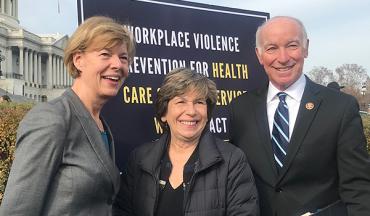Nurses and health professionals are one step closer to federal protection from workplace violence with the passage of the Violence Prevention for Health Care and Social Service Workers Act (H.R. 1309) in the U.S. House of Representatives on Nov. 21. The vote is a victory for AFT’s nurses and health professionals who championed this legislation from the beginning.
“This is a historic moment: We believe this is the first time the House has passed a positive worker health and safety bill in nearly 20 years,” said AFT President Randi Weingarten following the vote. “Every single worker in this country should have the right to a safe and welcoming workplace, no matter what job they do. They should know their employers have done everything possible to keep them safe from violence or harm. Yet our nurses, healthcare professionals and social service workers have no specific federal protections at work. Today, the House of Representatives passed a bill to change that. The representatives sent a strong message that violence on the job is not inevitable or acceptable for the millions of healthcare professionals who provide care in our communities but increasingly find themselves subject to workplace attacks.”
The bill, introduced by Rep. Joe Courtney (D-Conn.), requires OSHA to develop an enforceable safety standard for frontline healthcare and social service workers. This standard will require hospitals and other facilities to develop and implement comprehensive violence prevention plans and provide whistleblower protections for nurses and other workers facing violence.
Earlier this year, AFT nurses from across the country went to Washington, D.C., to share their own experiences with workplace violence at a congressional hearing. Patt Moon-Updike, a member of the Wisconsin Federation of Nurses and Health Professionals (whose career as a nurse was ended by a violent assault on the job), was one of these members. For Moon-Updike, the legislation is not just lip service. “It puts protocols in place to provide the equipment, personnel and training we need to do our jobs safely.”
Although nurses and health professionals on the frontlines agree with the need for this legislation, the American Hospital Association stands in opposition and asserts that many hospitals already have programs in place to prevent workplace violence. However, the growing rate of workplace violence—a 123 percent increase in hospitals and 201 percent in psychiatric and substance use facilities from 2007 to 2017—shows that voluntary efforts are not enough. By requiring healthcare employers to implement comprehensive violence prevention programs that identify high-risk situations, provide appropriate training for workers, and protective equipment will help reduce the number and severity of assaults. In addition, the legislation does not create a one-size-fits-all standard. Any prevention program should be tailored to the needs of the facility with input from frontline workers.
Mark Strube, a recreational therapist and member of AFT Healthcare-Maryland, believes in the power of prevention when it comes to addressing violent patients. Strube suffered a gruesome injury when his fingertip was bitten off by a violent patient who was being restrained. “I believe that if we would have had the restraint chair, which was not approved at my facility, the situation probably would not have happened,” he said. “Prevention starts when a patient comes through the door, and it’s an ongoing process.
“The staff are not the only ones who are traumatized by violence in our facilities; our patients who are exposed to it suffer, too,” said Strube. “It would be awesome if the government would have OSHA set a standard for workplace safety, because when I walk through the door of my facility every day, it will help me give my patients the best possible treatment.”
This story was updated from a previous version to reflect the passage of the bill.
[Adrienne Coles]

